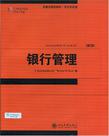银行管理
出版时间:2008-6 出版社:北京大学出版社 作者:Timothy W. Koch,S.Scott MacDonald 页数:562
Tag标签:无
前言
北京大学出版社策划出版的《金融学精选教材》系列图书与读者见面了,这是一件令人兴奋的好事。中国是一个金融人才短缺的国度,急需培养一大批高质量、具有国际先进知识的优秀金融人才,从而增强在经济全球化背景下的国际竞争力。而我们深知,要培养出一流的金融人才,不仅需要一流的师资和学者、一流的教学管理水平,而且还需要一流的教科书。作为在国内外从事了多年金融学研究和教学的学者,我们深感国内教材建设严重滞后,教材老化、脱离现实、远离前沿的现象非常严重。虽然随着近年来一批国外原版教科书的陆续引进,上述情况已经有所改善,但与国外相比还存在着很大的差距。将国外最优秀的著作引入中国,让国内的学生能够接触到国际最经典和前沿的理论知识,让国内的教师能够借鉴国际上最成熟先进的教材编写方式和教学方式,进而推动中国的现代金融学教育,是中国的教育界和出版界共同肩负的神圣责任和使命。正是本着这样一种强烈的使命感,北京大学出版社在组织国内顶级专家编写优秀金融学教材和专著的同时,特地精选了一批在国际上享有盛誉的经典力作。《金融学精选教材》系列所入选的图书包括三种类型:在专业领域内有着广泛影响的权威之作,比如J.Weston,Mark Mitchell和J.Harold Mul}mrin教授撰写的有着广泛影响的并购重组和公司治理教材Takeorers,Restructring,and corporate Governance(第4版);国外最具畅销性的金融学教材,如Copeland等人的nancial Theory and corporate policy(第4版);著名金融学专家的最新力作,如货币银行学专家Steplaen G.Cecchetti教授编著的最新货币银行教材Moneyr,Banking and Financial markts,等等。
内容概要
本书以风险管理为主线,重点介绍了决策过程,并为读者提供了一个理解银行管理的独特方法。在几个关键节中,介绍了如何运用金融模型或决策程序,并用样本数据加以展示。读者不仅可以观察到某些因素是如何影响信贷、投资、融资和定价决策的,而且可以更好地理解风险与回报之间的平衡关系。本书适用于高年级本科生和研究生的商业银行管理等相关课程,也适合作为银行从业者的培训教材。
作者简介
S.Scott MacDonald,美国得克萨斯农工大学博士sw银行业研究生院(SWGSB)基金会的董事长和首席执行官、银行董事集合会理事、南卫理公会派教徒大学Edwin L Cox商学院金融学副教授。MacDonald博士曾获得许多教学研究奖金,并经常在银行界、职业项目和银行业学校的研讨会上发表演讲。他在Jortnal of Financial Economice.The Journal of Business TheJournal of Futures Markets The Review of FuturesMarkets等多家学术期刊上发表了文童。Timothy W.Koch,美国普渡大学经济学博士,南卡罗来纳大学金融学教授、南卡罗来纳银行家协会主席。科罗拉多银行业研究生院院长.并在美国多所职业银行家研究生院任教。他还是南卡罗来纳大学银行投资与财务管理研究生院的指导老师,并且是银行业研讨会的领导者。作为美国财政部援助东欧私人银行业计划的一部分,他还给波兰、匈牙利、斯洛伐克和乌克兰的银行家讲授风险管理方面的课程。Koch博士的研究领域是银行风险管理、绩效分析和提高、金融期货和固定收益证券定价以及公共财政。他在Journal of Finance ,Joumal of,Financial &Quantitative Analysis Journal FuturesMarkets等多家学术期刊上发表了文章。
书籍目录
第1部分 银行业及其管制概览第1章 变迁中的银行业环境第2部分 银行绩效评估第2章 银行绩效分析第3章 非利息收益和非利息费用的管理第3部分 利息风险管理第4章 固定收益证券定价第5章 利率风险管理:缺口和收益敏感度第6章 利率风险管理:久期缺口和股权经济价值第7章 利用衍生金融工具管理利率风险第4部分 资金成本、银行资本和流动性管理第8章 银行融资和流动性管理第9章 资本的有效利用第5部分 企业和个人信贷第10章 信贷政策和贷款特征概述第11章 商业贷款评估第12章 消费信贷评估第6部分 投资组合管理和专题第13章 投资组合管理第14章 全球银行业
章节摘录
interest rate environments.This net interest income simulation,or"What if?"forecasting'provides Intormation regarding how much net interest income changes when rates are alternatively assumed to rise and ta.1lby amounts.It takes into account shifts in asset and liability composition and embedded options in a bank's asset0 and liabilities and off-balance sheet activities.It provides a better understanding of potential changes in 00rnmgs than simple static models.As such,it is labeled earnings sensitivity analysis.Throughout,we provid0 num examples that clarify how changes in interest rates and other factors affect potential earningsPrior to the deregulation of interest rates in the mid-1980s,banks and savings and loans were effectively guaran'teed a positive spread between what they earned in interest on loans-and securities and what they paid in nter liabilities.Virtually all institutions charged the maximum rates allowed on assets and paid the maxlm."m rates.a1wed on liabilities.They were not allowed by regulation to compete on the basis of interest rates l hus,charging 6 Dercent on loans and paying 2 percent on deposi ensured a 4 percent spread if loans didn't default Si"0e mterest rate deregulation,banks are no longer guaranteed a profitable spread between asset yields aJld mng costs Intere.0t rate fluctuations alter bank earnings and the value of stockholders'claims unless management implements to reduce their impact.Interest rate risk management is extremely important because no one can consisten.tly.for.e.-cast interest rates accurately A bank's asset and liability management committee(ALCO)or alternativey:management committee,is responsible for measuring and monitoring interest rate risk,It also recommends pricing,investment,funding,and marketing strategies to achieve the desired trade。off between risk and expem.remm. Bank managers generally have greater expertise in managing credit risk than interest rate risk,esp,aIy atm:institutions.This reflects the perception that earnings problems and possible bank failure are more close.1y.tied to bad loans than mismatched pricing of assets and liabilities.They often rely on brokers to recommend specitic j"veStmem securities for purchase and sale and outsource interest rate risk analytics to consulting,compans.Duri"g.tnel010 1990s through 2004,many banks invested heavily in callable federal agency securities and mortgage。backed secu.n。ties with little Or no default risk,but with extensive call and prepayment risk.With the decline In interest。ates,tneY saw their interest income drop as borrowers refinanced high-rate mortgages so that mort ;age'backed securitie0 were paid off early and issuers called high-rate agency bonds and refinanced them at lower rates The fundamental issue is whether bank managers understand the magnitude of interest rate risk that tneY assume and whether earnings will fall sharply when interest rates change adversely.The basic q.ues.tio"Do banks understand the nature of their interest rate bet?"and"Do banks understand how big the bet lsr Banks use two basic models to assess interest rate risk.The first,GAP and earnings sensitivity analysis,empha-sizes income statement effects by focusing on how changes in interest rates an.d the bank's balance sheet attenn。etinterest income and net income.The second,duration gap and economic value of equity analysis,emphas.1zes.tn market value of stockholders'equity by focusing on how these same types of changes affect the market valu0 ot 00一Unexpected changes in interest rates can significantly alter a bank's profitability.GAP and earnings!ensitivitYanaiys。is targets the volatility in net interest income associated with changing interest rates and balance sheetposition.epending on the cash flow characteristics of a bank's assets and liabilities and the exince of embedrde-d——options,interest rate changes may raise or lower net interest income.Consider a bank that makes 30-year,fixed-rate mortgage loans financed primarily with 3-month to deposits.Why would management choose this portfolio?The bank receives interest and principal payments 0"themortgages monthly and pays monthly interest on deposits.With an upward sloping yield curve,the mortg.gat ewill exceed the short-term deposit rates by a large spread.For example,if the mortgage rate is 7 percent and trates are 2 percent,the initial spread is 5 percent.This initial spread should be large enough to cover the Cos.t of doingbusiness,cover the expected change in rates over the investment horizon,and provide for a reasonable proht What happens if interest rates change?Because the mortgages have a 30-year maturity,these rates are flxed as1ong as the mortgages are outstanding.Rate changes will,therefore,affect the deposit rates and not the mortgage rates directly.If the deposit rates rise,the spread wiu fall below 5 percent.Similarly,if deposit rates fall,the s.preadwill rise above 5 percent.The bank's choice oflong-term,fixed-rate assets financed by short。term deposits evidences a specific interest rate bet.Rising rates lower net interest income while falling rates mcrease net interest lncom.Of course。it's not quite that simple.For one,the balance sheet is dynamic and thus changing constantly overtime.Rate changes are only one factor that affects earnings.Similarly,an upward sloping yield curve indicat.es.a consensus view that short.term rates are going to increase over time.For a bank to take the position deoc'ibod,management is essentially betting that rates will not rise above expectations.Finally,there are embedded optio"sin the mortgagesthatwillm,dyalterthecashflowsandeventuaLinterestpaymentsandreceiptsifrates change..Inthe case of falling rates,some mortgage borrowers will refinance and the bank will lose some interest lncom0 be-causeitmust reinvestthe.proceedsatlower rates.
编辑推荐
《银行管理(第6版)(英文影印版)》以风险管理为主线,重点介绍了决策过程,并为读者提供了一个理解银行管理的独特方法。在几个关键章节中,介绍了如何运用金融模型或决策程序,并用样本数据加以展示。读者不仅可以观察到某些因素是如何影响信贷、投资、融资和定价决策的,而且可以更好地理解风险与回报之间的平衡关系。《银行管理(第6版)(英文影印版)》适用于高年级本科生和研究生的商业银行管理等相关课程。也适合作为银行从业者的培训教材。◎全书按最新的金融管制条例进行了全面更新,从而使读者了解到最新的银行监管和竞争环境。◎介绍了最新、最全面的银行绩效评估体系。更新了国际银行业、美国银行海外规模和作用以及外国银行在美国的所有权及其构成的数据和分析。◎全面讨论了联邦住房贷款银行预付款在融资和流动性管理中的运用,并讨论了新巴塞尔资本标准。◎广泛使用新的分析工具和方法,如在其他投资工具评估中引入的总回报率分析和期权调整利差分析。◎介绍了编制现金损益表的全过程,并提供了一种预测潜在借款人未来业绩的方法。
图书封面
图书标签Tags
无
评论、评分、阅读与下载
用户评论 (总计5条)
- 很经典,就是字有点小,读起来比较吃力。
- 很好,很清晰,很满意
- 书本质量不错 可是很重 像一块砖头 书里面的英文字非常小 看着很累不过是我们学校的教材书 所以没办法。
- 很好,很新,没有破损。速度很快
- 指定教材 所以买了 不过好像应该搭配中文版本 不然真的看不懂
